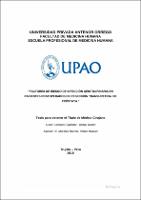Mostrar el registro sencillo del ítem
Factores de riesgo de infección genitourinaria en pacientes postoperados de resección transuretral de próstata
| dc.contributor.advisor | Morales Ramos, Víctor Manuel | |
| dc.contributor.author | Campos Capristán, Anibal Martin | |
| dc.creator | Campos Capristán, Anibal Martin | |
| dc.date.accessioned | 2019-06-06T17:07:00Z | |
| dc.date.available | 2019-06-06T17:07:00Z | |
| dc.date.issued | 2019 | |
| dc.identifier.uri | https://hdl.handle.net/20.500.12759/4914 | |
| dc.description.abstract | Objetivo: Identificar los factores de riesgo de aparición de infección genitourinaria en pacientes postoperados de resección transuretral de próstata (RTUP). Material y métodos: Se realizó un tipo de estudio de casos y controles poblacional. La población estudiada fue de 122 pacientes post operados de RTUP en el periodo de julio del 2016 a julio del 2018, los cuales se dividieron en dos grupos según la presencia de infección urinaria: 61 casos y 61 controles. Los posibles factores de riesgo fueron procesados mediante estudios bivariados y multivariados de regresión logística. Resultados: En el análisis bivariado se halló que los pacientes que tuvieron sonda vesical antes de ingresar a la cirugía tuvieron un OR de 12,21 y fue significativa (p< 0.05), de la misma manera se encontró un valor significativo en cuanto al tiempo operatorio ≥60 minutos (p<0.05) con un odds ratio de 5,81. En el análisis multivariado se corroboraron los resultados obtenidos en el estudio bivariado. Conclusiones. El uso previo de sonda vesical y el tiempo operatorio mayor a 60 minutos son factores de riesgo para desarrollar infecciones genitourinarias en pacientes post operados de RTUP. | es_PE |
| dc.description.abstract | Objective: To identify the risk factors of urinary infections in patients who were operated with transurethral resection of the prostate (TURP). Material and Methods: A case-control study, poblational was carried out. The population studied was 122 patients, who were post operated of TURP during the period July 2016 – July 2018; which were divided into 2 groups according to the presence of urinary infection: 61 cases and 61 controls. The possible risk factors were processed through univariate and multivariate logistic regression studies. Results: In the bivariate analysis it was found that the patients who had bladder catheter before entering the surgery had an OR of 12.21 and it was significant (p <0.05), on the same way, a significant value was found regarding operative time ≥ 60 minutes (p <0.05), with an odds ratio of 5,81. In the multivariate analysis we could corroborate the results in the bivariate analysis. Conclusions: The previous use of bladder catheter and the operative time greater than 60 minutes are risk factors for developing genitourinary tract infections in post-operated TURP patients. | en_US |
| dc.description.uri | Tesis | es_PE |
| dc.format | application/pdf | es_PE |
| dc.language.iso | spa | es_PE |
| dc.publisher | Universidad Privada Antenor Orrego | es_PE |
| dc.relation.ispartofseries | T_MED.HUMA_2569 | |
| dc.rights | info:eu-repo/semantics/openAccess | es_PE |
| dc.rights.uri | https://creativecommons.org/licenses/by/4.0/ | es_PE |
| dc.source | Universidad Privada Antenor Orrego | es_PE |
| dc.source | Repositorio Institucional - UPAO | es_PE |
| dc.subject | Resección transuretral de próstata | es_PE |
| dc.subject | Infección urinaria | es_PE |
| dc.title | Factores de riesgo de infección genitourinaria en pacientes postoperados de resección transuretral de próstata | es_PE |
| dc.type | info:eu-repo/semantics/bachelorThesis | es_PE |
| thesis.degree.level | Título Profesional | es_PE |
| thesis.degree.grantor | Universidad Privada Antenor Orrego. Facultad de Medicina Humana | es_PE |
| thesis.degree.name | Médico Cirujano | es_PE |
| thesis.degree.discipline | Medicina Humana | es_PE |
| dc.subject.ocde | https://purl.org/pe-repo/ocde/ford#3.02.27 | es_PE |
| renati.type | https://purl.org/pe-repo/renati/type#tesis | es_PE |
| renati.level | https://purl.org/pe-repo/renati/level#tituloProfesional | es_PE |
| renati.discipline | 912016 | es_PE |
| dc.publisher.country | PE | es_PE |
Ficheros en el ítem
Este ítem aparece en la(s) siguiente(s) colección(es)
-
Medicina Humana [3015]


